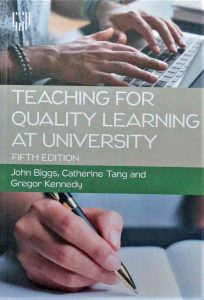CONSTRUCTIVE ALIGNMENT
In my last year of teaching, I had a class of 82 schoolteachers who were studying how psychology could be applied to teaching. It suddenly struck me how silly it was to give the usual exam or final assignment, in which my students tell me what I had told them about applying psychology to education. Rather, they should be telling me how they themselves could apply what psychology they knew to improve their teaching decisions – that was the underlying intended outcome of the course. So that is what I asked them to do, by putting their evidence for psychologically-driven teaching in a portfolio. After the initial shock, they saw the relevance of the course to their own teaching. I received the best teacher ratings I’d ever had. Thus was constructive alignment born.
In constructive alignment, we start with the outcomes we intend students to learn, and align teaching and assessment to those outcomes. The outcome statements contain a learning activity, a verb, that students need to perform to best achieve the outcome, such as “apply expectancy-value theory of motivation”, or “explain the concept of … “. That verb says what the relevant learning activities are that the students need to undertake in order to attain the intended learning outcome. Learning is constructed by what activities the students carry out; learning is about what they do, not about what we teachers do. Likewise, assessment is about how well they achieve the intended outcomes, not about how well they report back to us what we have told them or what they have read. The SOLO Taxonomy helps to map levels of understanding that can be built into the intended learning outcomes and to create the assessment criteria or rubrics. Constructive alignment can be used for individual courses, for degree programmes, and at the institutional level, for aligning all teaching to graduate attributes.
Constructive alignment is an example of outcomes-based education (OBE). Unfortunately, some versions of OBE have attracted criticism; it has been used in some secondary school systems in a post-modern mishmash of outcomes, and in the US particularly, across institutions to serve a managerial agenda. My version of OBE, constructive alignment, is concerned only with improving teaching and learning and as such has been successfully implemented in universities all over the world. Google “constructive alignment” and you will see up to a million references, none of which have anything to do with left wing propaganda or with managerialism.
See also: Teaching for Quality Learning at University (Open University Press/McGraw Hill, 2022, 5th edition) has been rewritten with Catherine Tang and our new coauthor Gregor Kennedy. It includes sections on educational technology and how that can be used to implement constructive alignment, recent studies f constructive alignment in line with how the tertiary scene has changed in the last 11 years Purchase online from:
2022, 5th edition) has been rewritten with Catherine Tang and our new coauthor Gregor Kennedy. It includes sections on educational technology and how that can be used to implement constructive alignment, recent studies f constructive alignment in line with how the tertiary scene has changed in the last 11 years Purchase online from:
![]() Amazon USA
Amazon USA ![]() Amazon UK
Amazon UK
Teaching Teaching & Understanding Understanding an award-winning DVD from the University of Aarhus, Denmark, written and directed by Claus Brabrand.
To view the 19 minute short film or to order the DVD, go to
![]() www.daimi.au.dk/~brabrand/short-film/
www.daimi.au.dk/~brabrand/short-film/